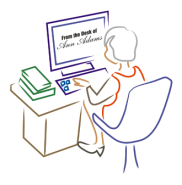While initially Gary often used the terms the Movie Technique and Tell the Story interchangeably he now clarifies them separately.
The main difference? Privacy. The movie is done silently in their head, Tell the Story, as the terms indicates, is told out loud.
In Tell the Story the person does just that, tells a story of what happened – out loud – in the same way as you’d tell a friend what happened. More instructions are necessary for  The Movie Technique as you have less information, hence the need to ask how long the movie is and what the title is and how many crescendos. You are encouraging them to “see what they saw, hear what they heard, feel what they felt, and pay attention to any smells and tastes. In both Tell the Story and the Movie Technique, you address each part of the event in the order it happened. You then tap for each aspect that carries any level of intensity in the order that it occurs before moving on to the next aspect.
The Movie Technique as you have less information, hence the need to ask how long the movie is and what the title is and how many crescendos. You are encouraging them to “see what they saw, hear what they heard, feel what they felt, and pay attention to any smells and tastes. In both Tell the Story and the Movie Technique, you address each part of the event in the order it happened. You then tap for each aspect that carries any level of intensity in the order that it occurs before moving on to the next aspect.
Addressing aspects can be more challenging when you don’t know the details. You tap for the “title” they give the movie or an emotion or, at times, the physical feeling that thinking about the aspect or event brings up.
After tapping to reduce the intensity of each part of the movie to zero the client then tells the story and stops to clear any remaining intensity as the story progresses. (However, the client can choose to keep their story and details to private.) As a final test they rerun the movie. Ask them to make their movie vivid with what they “see, hear, feel, smell and taste.” Continue to tap if necessary to deal with any remaining intensity. Often they “see” the movie very differently and the entire scene is reframed, changing the perceptions of the event and their view of themselves.
What is confusing for those learning EFT is the difference between the tutorial instructions for using the Movie Technique and what Gary demonstrated on the DVDs. The tutorial stated “go through the movie in their mind, starting with a low intensity segment…” Gary, however, often tapped first for what he called the “crescendo” of the story, then the second most important crescendo, etc, until they reported the overall movie intensity was a zero. Because of the generalization effect, it often does work to address the “big” sections first, however, as a practitioner your job is help your client clear their issue completely. This is best done by being methodical and thorough and addressing each involved aspect in turn.









I use the movie technique out loud rather than in silence. (After we tap on the title and after we tap on any intensity with the thought of even running the movie.) If they narrate out loud it’s easier for me to catch aspects. Narrate, tap at intensity, start again from a little bit back, narrate, tap at intensity, start again from a little bit back from that, etc. and when all aspects are down – start over from the beginning and make sure all is clear. But of course, if it’s delicate, they don’t have to say anything out loud!
I use Tell the Story frequently with my clients, but I have them tap continually while telling me the story. Saves time and eliminates a lot of the minor or low-intensity issues almost effortlessly. Often clients want to jump in with whatever has happened since I last worked with them, so I have them just tap while they tell me about it. We can get big changes quickly that way.
Tell the Story, or some version thereof, is the most frequently used of the EFT techniques. When a client really wants to talk, and they are familiar with EFT, continuous tapping can be a useful way to include tapping at the same time. Efficient :-). Testing is still important, however, to go back over each aspect of the story to assure that all of the parts have been reduced to zero and that other aspects don’t come up in the retelling.